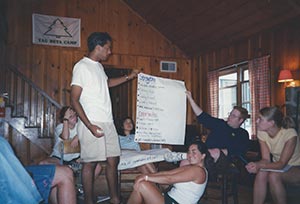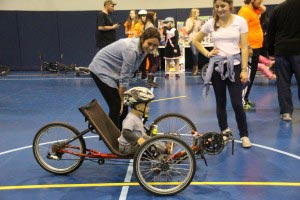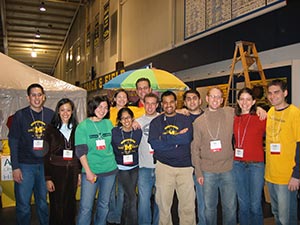“Dancers are the messengers of the gods.” – Martha Graham
Like any good Wolverine, Bryan Ackerman, BA ’00, has “totally brainwashed” his two young kids. The 6-year-old is especially passionate about her future in the maize and blue.
In fact, she was right by her father’s side March 12-13, when Ackerman, one of the founders of the U-M Dance Marathon, tuned into the live feed of the 19th annual event, dubbed VictorThon.
“She loves it,” says the Washington, D.C.-based attorney, a VP at Sentrillion.
This year Dance Marathon participants raised $475,807 to support physical rehabilitation therapies for children living with birth defects, injuries, or disease. Since 1998 students have raised more than $5.5 million to support the children and their families.
“Rehab touches so many children,” Ackerman says. “Now, with two kids of my own I recognize the importance of the cause. And it’s amazing to see ideas that I helped develop still happening to this day.”
His one regret is that he never had a chance to actually dance in the marathon. But he’s holding out hope for his daughter. The other day she came home from school with her “bucket list” of things she needs to achieve before she turns 100. The very first item, in her misspelled kindergarten handwriting, reads: “I want to go to Dance Marathon.”
It was one of the proudest moments of Ackerman’s life.
They work hard for the money
For alumni who predate Dance Marathon’s inception it may be difficult to conceptualize its profound and far-reaching impact. What started in the late ’90s as a fundraising event that needed an organization quickly evolved into a fundraising organization that produced an event. Well, actually several events.
By year three the leadership team had transitioned the organization into an independent 501(c)(3). Today U-M’s Dance Marathon is the largest student-run organization in the state, inspiring thousands of dancing volunteers to support programs at C.S. Mott Children’s Hospital in Ann Arbor and Beaumont Children’s Hospital in Royal Oak. Beaumont is home to Children’s Miracle Network, an early Dance Marathon partner.
Student dancers always have been organized into teams and paired with a family. Personalizing the philanthropy is key, and volunteers often maintain long-term relationships with “their kids,” says Evan Meyers, BA ’99, partner at McGuire Law, P.C., in Chicago. He is a founding member of the organization’s leadership team, and was its second executive director.
“I remember one father saying, ‘You’ve all been standing here for hours, but this organization stands for those who can’t really stand on their own,’” Meyers says. “That was very inspirational to hear.”
Stand in the place where you live
The symbolism is lost on no one: able-bodied youths standing on their collective feet for 24 consecutive hours (and 30 back in the day) to support children who can’t. But despite all the publicity for the physically and emotionally taxing event, it is important to remember the dance itself is just one experience – albeit the most emotional one – that caps an intense year of volunteer responsibilities akin to a part-time job.
The organization attracts a diverse talent pool that touches every corner of campus: members of academic organizations, student government, the Greek system, the administration, the alumni, athletics, and more. Many volunteers return year after year.
“You find similar passions bridge all gaps,” says Nicole Armbruster, BBA ’10, an associate director in market research at Clorox in San Francisco. “When you go though something like this together and you make this big of an impact, you come to understand true character, true motivation. And that creates a strong bond.”
Volunteers in the trenches organize fundraising and social activities with the children and families. They steward internal and external donors. They work with hospital personnel, and volunteer with the various rehab programs. They perform every management and operational function required of a complex, quasi-professional organization.
“One of the first things we instilled was that it was not about the money,” says Ackerman. He was the organization’s third executive director and continues to advise students on legal and contractual matters. “We wanted to make a lasting program, a quality organization. And we always said that if we delivered quality the money would just come.”
Love songs
The quality has paid off, both professionally and personally, says Kathleen (Olson) Hinkley, BS ’10.
“Part of my gratitude for the organization is that people saw qualities in me that I didn’t see in myself,” she says. Hinkley, in her year as executive director, discovered a talent for fundraising that evolved into her current role as a director of development at the University of Wisconsin Foundation, supporting the Law School.
When she first danced as a freshman, Hinkley’s then-boyfriend, Tim Hinkley, BS ’10, just dropped in to boost morale in the wee hours. But as the years progressed and Dance Marathon consumed more of Kathleen’s time, Tim joined her team, captained his own, and “shared” a family with her so they could spend time together. They even visited the child in the hospital.“He was really wonderful throughout the entire four years,” she says. “I knew after that we would get married.”
Not surprisingly, two of the couple’s bridesmaids and their wedding DJ came from Dance Marathon.
Pump it up
Hinkley, along with Armbruster and Marah Casey, BA ’12, continues to coach students behind the scenes. They’re helping to develop a new pledge program and working to better engage and steward donors, among other things. It’s right up Casey’s alley; she is a fundraising specialist for Teach for America in the Detroit region.
“I have a great memory from my senior year when we raised the final number at the end,” Casey says. That was the first year Dance Marathon broke the half-million-dollar mark, and Casey got to hold up the five. Even though the dancers were sitting down for the first time in over a day, everyone immediately jumped back to their feet in jubilation.
“You’re so tired but your adrenalin is still pumping. I’ll never forget the energy and the excitement in that building.”
That potent mix of exhaustion and exhilaration sticks with you year after year. Meyers recalls the original group of dancers breaking out in a spontaneous group hug at the conclusion. By the second year that hug had doubled in size. Now it’s likely impossible for the crowd of a thousand-plus to execute such a feat.
“It’s so rare and rewarding to be involved in starting something and to see it grow so quickly before your eyes,” Meyers says. As an ongoing adviser, he has visions of a future in which Dance Marathon would create something concrete from the ground up – say, a camp or a community center.
“That’s power”
Inder Singh, BS ’98, spearheaded the initial idea for a Dance Marathon at U-M after hearing about a friend’s experience with Penn State’s organization (founded in 1973). Singh’s friend, (“a typical meathead fraternity guy, and I can say that because I was in a fraternity”) had just attended the funeral of a child his house had supported through the marathon.
“He didn’t want anyone to see that he was crying at the funeral,” Singh says. “But then he told me every one of the 88 guys in his fraternity had tears streaming down their faces. That’s how well they knew this kid. And I remember thinking, ‘If you can reduce a whole fraternity of 88 guys to one emotional mass, that’s power.’ And I wanted to bring that power to Michigan.”Singh’s goal for U-M’s marathon was two-fold. Of course he wanted to support children who needed physical rehabilitation and socialization. But he was most interested in reviving a spirit of service on campus.
“I really wanted to do this for the students,” he says. “This was all about inspiring them to come together and actually make a difference while they were still in college. It all comes down to passion. And passion is contagious.”
Start me up
But Singh had no idea what he was in for.
“Dance Marathon completely and utterly changed the trajectory of my life,” Singh says. “I saw the look in the eyes of the kids and the families we supported and thought: ‘That’s what I want in my career. That look.’”
So instead of going to medical school he pursued a career as a social entrepreneur.
“Without getting too academic about it, I learned lessons about how to motivate people, build a shared vision, and map incentives for people to do something for free,” he says. “And those are the lessons that have helped drive my entire career.”
Today Singh is founder and CEO of Kinsa, a venture-backed startup in San Francisco seeking to track and stop the spread of disease by creating a real-time map of human health. Prior to founding Kinsa he was executive VP at the Clinton Health Access Initiative where he built teams and helped negotiate deals that dropped the price of drugs for AIDS, malaria, and TB by up to 90 percent.
“We put millions of people on life-saving treatments,” he says, “and all of that started at Dance Marathon.”
Dance with me

The ultimate bucket list. (See larger image. Courtesy of Bryan Ackerman.)
Singh spoke at the 2016 VictorThon and says he was surprised to see how closely the much-larger modern event resembled the original. Even the crew assembling the stage was the same team from the ’90s.
“Hundreds of people helped us that first year,” Singh reflects. “But at first so many people laughed at us. They said our ambition was too huge and they wondered how we would convince people to volunteer.”
When the team hit an administrative snag that threatened to cancel the premier event, though, “all those same people came out to help.”
With the organization’s 20th anniversary on the horizon, he has been talking to Ackerman and Meyers about returning to campus in 2017 and celebrating this growing tradition they launched.
As for Ackerman, if he does make it to Dance Marathon next year, he hopes to fulfill a goal that’s long been on his own bucket list. “I’m thinking I might have to dance,” he says.
And you better believe his daughter will be watching.
(Top: VictorThon 2016. Image: Allison Farrand)









Howard Zoller - 1974
NOW THOSE ARE THE REAL MICHIGAN MEN AND WOMEN.
GO BLUE !!!!!
Reply
Jill Wessel
I participated and attended Dance Marathon in the mid to late 90’s before and while my sister was in attendance at U of M. However, we were there for a more important reason. My cousin was one of those children, we were one of those families. And, it is humbling to hear how this event has impacted all of your lives, because your hard work has impacted our lives as well. Because of all of you, this past year, my beautiful, amazing cousin was able to get married. She has been able to over come obstacles. Not without hard work, persistence and amazing Doctors and staff. The University of Michigan and Children’s Miracle Network were all part of this. So, from the bottom of my heart, and from my family, thank you will never be enough, Go Blue!
Reply
Bryan Ackerman - 2000
I wanted to write and thank you again for the terrific story that you wrote about Dance Marathon at the University of Michigan in March 2016. I thought you may be interested to know that I am living up to the commitment I made in your article and will be dancing at VictorThon on March 25-26, 2017. (My fundraising page: http://dmum.donordrive.com/participant/bryan_ackerman.) Please wish me luck as I try to keep up with the students and stand for 24 consecutive hours!
Reply